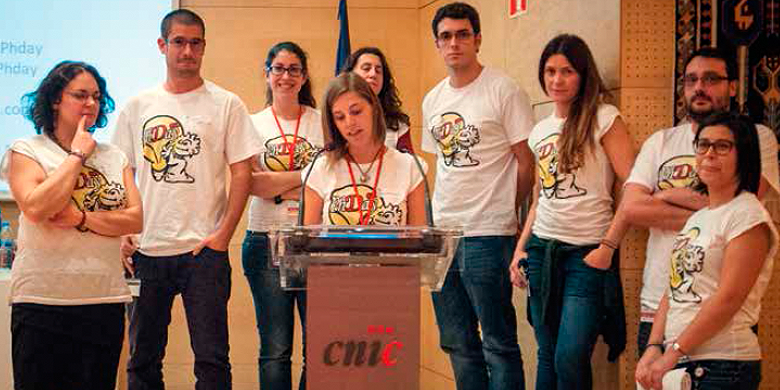The ‘Little Ones’ take charge
The importance of their work is undeniable, but we seldom hear about them.
They are the predoctoral researchers, as well as those who already have their PhD title in their pocket but don’t yet have their own research group. However, last December 1, these ‘juniors’, who are set to be a major talking point, organized an event at the CNIC, the PhDay, that would have not been out of place at any leading international conference. It was the first such event at the Center and was such a success that it will be repeated this coming November 27.
Bárbara González Terán, a researcher in Dr. Guadalupe Sabio’s lab, was the main organizer of this event, together with her colleague Daniel Torralba, from Francisco Sánchez-Madrid’s group. Although Bárbara feels that she is privileged to receive “so much technical training” at the CNIC, where she is working toward her PhD thesis, she feels that improvements could be made in other areas. In particular, she mentions the stress of giving presentations, the need to develop skills in networking through researcher networks, and writing and publishing scientific articles.
Bárbara points out that there is generally better provision of training in these areas in universities in the United States, where postrgraduates have to present their projects regularly and receive training in communication skills.
So from the earliest planning stages of the PhDay it was clear that there were many issues to be addressed, and this ambitious goal made the design of the program challenging. But even before this, the first task was to get approval from the CNIC. The Direction gave the project the green light after a presentation given by two representatives of the predoctoral researchers. With this approval, the team began planning the conference, an event organized in its entirety by pre- and postdoctoral researchers and masters students;
For once, the group leaders would be out of the spotlight, both as presenters and participants. “Part of our aim was to create a forum in which early stage researchers would be disinhibited from speaking,” comments González Terán.
The quality of the presentations was comparable with any more traditional meeting. Researchers working in Spain and abroad tackled key themes in the training of tomorrow’s scientific leaders
There was just one exception to this rule. In a demonstration of the Center’s approval of the initiative, the inaugural presentation was given by CNIC General Director Dr. Valentín Fuster, who was delighted to have this opportunity to show support for young researchers, one of the core missions of the CNIC.
The quality of the presentations was comparable with any more traditional meeting. Researchers working in Spain and abroad tackled key themes in the training of tomorrow’s scientific leaders.
Scientific themes were presented in a series of 15 minute talks, and dealt with subjects such as the regulation of genome architecture during heart development. In addition, the meeting dedicated time to more general issues, such as motivation in the laboratory, the ways in which basic research discoveries can be converted into successful businesses, and the links between basic and clinical research.
In an event that emphasized enterprise, business initiatives derived from research carried particular weight. There was a dedicated session called Beyond the bench, where ideas become reality. “We invited people who are driving their own projects, to show participants that there are many alternatives after the doctorate,” González Terán.
And to motivate the participants in their scientific career, who better than Dr. Joan Guinovart, whose presentation was called Everything I wanted to know about science but was afraid to ask. Dr. Guinovert, like all the invited speakers, participated in the PhDay for free.
The level of satisfaction of the participants was in direct proportion to the effort put in by the organizers. In a post event survey, 100% of attendees expressed their enthusiasm for future PhDays, and many people expressed an interest in organizing the next event.
Plans for the second edition are already underway, and it promises to surpass even the high quality of the first meeting. In a preview of upcoming innovations, González Terán spoke of the intention to include Elevator Pitches, a feature of many congresses in the US. These competitions consist of short conversations, about the duration of an elevator ride, in which a young investigator tries to convince a group leader of the validity of an idea or project.
Another goal is to include more presenters from outside Spain, and the team is working on several other ideas to make the meeting even more attractive.
Like all good scientific meetings, the PhDay included a poster session, and prizes were awarded to the three judged to be the best. On this occasion, the prize winners were Irene Rubio-Ferrera of the Universidad Autónoma de Madrid, for her poster The role of scribble and daschshund in segmental specification of neuronal subtypes, Alberto Hidalgo of the Universidad Complutense de Madrid, for his poster Biophysical evaluation of pulmonary surfactant as a drug delivery system, and predoctoral CNIC researcher Víctor Fanjul Hevia, for his poster Hutchinson-Gilford Progeria Syndrome as a model to study heart disease in aging.











